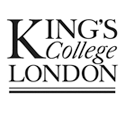

The ninth meeting of the South East Mathematical Physics Seminar will be held on Monday 17th July 2017 at King's College London in room K3.11. The meeting is partially supported by supported by a London Mathematical Society Joint Research Groups grant.
There is no registation fee, and no need to register in advance, but currently all visitors to King's are required to sign in at reception, and it would be very helpful and speed matters up if we knew who was coming in advance. Please email Gerard Watts if you are likely to attend.
| 13.30 - 14.00 | Coffee | ||
| 14.00 - 14.50 | E.-M. Graefe | ||
| 14.50 - 15.40 | M. Collura | ||
| 15.40 - 16.10 | Coffee | ||
| 16.10 - 17.00 | J.P. Garrahan |
| Mario Collura (Oxford) | |
| Non-equilibrium transport in the XXZ spin-1/2 chain: Domain-Wall analytic solution | |
| Juan P Garrahan (Nottingham) | |
| Boundary driven open quantum chains: fluctuating hydrodynamics, large deviations and hyperuniformity | |
| I will consider the problem of quantum chains driven by dissipative interactions at the boundaries - and subject to dissipation at the bulk - in order to study the interplay between coherent and dissipative processes in their transport. I will discuss how dynamics on large scales can be described in terms of fluctuating hydrodynamics, in analogy with what is done in classical exclusion processes. This is an important simplification as it allows to apply the methods of macroscopic fluctuation theory to compute the large deviation statistics of time-integrated currents and dynamical activities. For the case of fermionic chains, singularities in large deviation functions indicate the existence of distinct dynamical phases and phase transitions between them at the fluctuation level, manifested in singular changes in the structure of dynamical trajectories. I will discuss how these results fit more broadly in the application of classical ideas to open quantum non-equilibrium systems. | |
| Eva-Maria Graefe (Imperial) | |
| PT-symmetric random matrix ensembles using split-quaternionic numbers | |
| Random matrices play a crucial role in various fields of mathematics and physics. In particular in the field of quantum chaos Hermitian random matrix ensembles represent universality classes for spectral features of Hamiltonians with classically chaotic counterparts. In recent years the study of non-Hermitian but PT-symmetric quantum systems has attracted a lot of attention. These are non-Hermitian systems that have an anti-unitary symmetry, which is often interpreted as a balance of loss and gain in a system. In this talk the question of whether and how the standard ensembles of Hermitian quantum mechanics can be modified to yield PT-symmetric counterparts is addressed. In particular it is argued that using split-complex and split-quaternionic numbers two new PT-symmetric random matrix ensembles can be constructed. These matrices have either real or complex conjugate eigenvalues, the statistical features of which are analysed for 2 × 2 matrices. | |
The meeting is in room K3.11, on the third floor of the King's building. Here is a map of the campus [the King's building is in red] and a map of the second floor of the King's building
Local travel information may also be found here.
London transport information is available here. The nearest tube station is Temple; other stations within walking distance are Embankment, Charing Cross, Covent Garden and Holborn.
Train information may be obtained from here. The nearest national rail stations are Charing Cross, Waterloo & Waterloo East, Blackfriars and City Thameslink.
Limited funds are available to help with travel expenses of participants with no other source of funding. We hope that this will encourage postgraduate students and postdocs to attend the meeting. Please email Clare Dunning (tcd at kent.ac.uk) in advance if you would like to apply for support. A claim form is available here